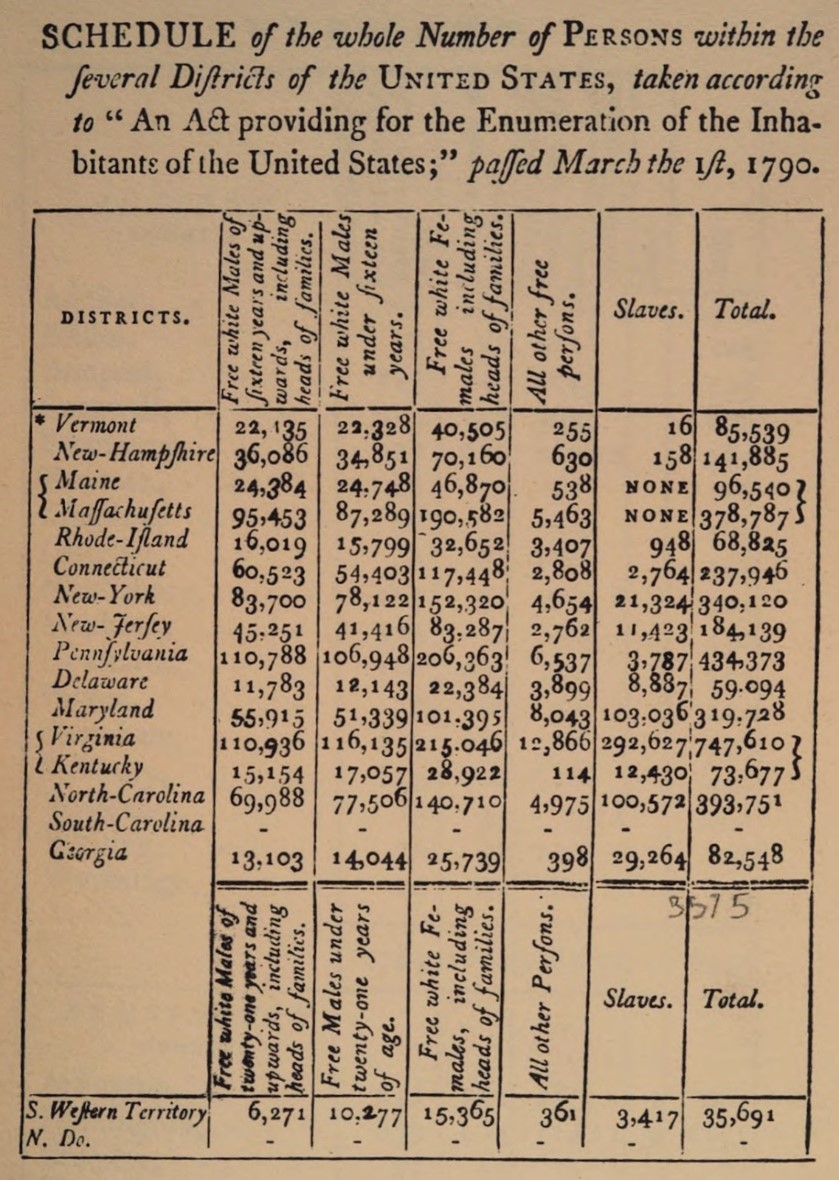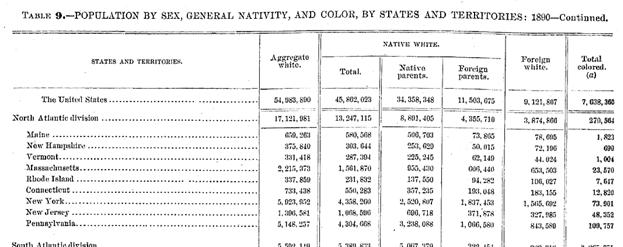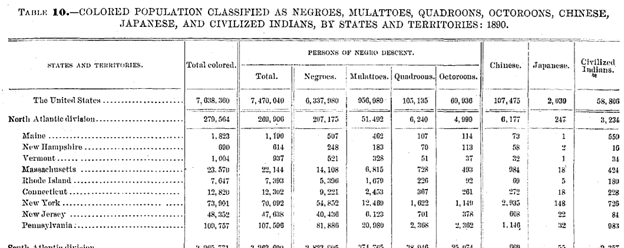Why data on race and ethnicity are collected in the United States
In the period before independence in the United States, the colonial administrations irregularly collected demographic information, including data on race. The U.S. government has subsequently collected data on race since the first federal census was taken in 1790.1 In the early years, this data collection was in support of discriminatory constitutional provisions, laws, court decisions, and policies. Conversely, in later years, federal agencies argued that collection of data on race and ethnicity was essential in order to combat discrimination.2
As originally ratified on June 21, 1788, the provisions of Article 1, Section 2, Clause 3 of the U.S. Constitution required an enumeration of the population for the purposes of apportionment of representatives and of direct taxes among the states.3 That clause excluded “Indians not taxed” and required that an enslaved person be counted as only three-fifths of a person.4 (Some of the provisions of Clause 3 were later changed by the Fourteenth and Sixteenth amendments to the Constitution).
The census of 1790 was designed to enable those (and other) constitutional provisions. During debate in Congress on the exact questions to be asked during the first Census in 1790, James Madison successfully argued for further expanding the census questions to include “two age groups of white males, and freedom or servitude of the colored population.”5 (See Fig. 1.) Thus was “launch[ed] the collection of racial data by the federal government that continues today.”6
Figure 1. Form of the 1790 Census schedule

Source: An Act Providing for the Enumeration of the Inhabitants of the United States, Public Law 1-2, Chapter 2, The Public Statutes at Large of the United States of America I (1790): 102, https://www.loc.gov/collections/united-states-statutes-at-large/about-this-collection/.
Since then, many considerations have influenced how data on race and ethnicity have been collected and how people have been classified in the censuses, including politics, policy concerns such as discrimination and civil rights, social attitudes, and the racial demographics of the U.S.7 Concern for civil rights led to a successful effort in the 1970s to standardize the collection of data on race and ethnicity by federal agencies “in response to needs expressed by both the executive branch and the Congress to provide for the collection and use of compatible, nonduplicated, exchangeable racial and ethnic data by Federal agencies.” 8
As of this writing (2022), the most recent standard for the classification of federal data on race and ethnicity was promulgated by the Office of Management and Budget in 1997 after consultation with federal agencies and the public.9 That standard introduced the ability for a respondent to report more than one race. The office of the Chief Statistician of the United States, Karin Orvis, began a review of that standard in Summer 2022.10 The U.S. Census Bureau continues its research on race and ethnicity with the goals of improving the questions and the quality of the data.11
Contemporary uses for data on race and ethnicity are summarized in a 2017 Census Bureau publication:
These data are required for federal and state programs and are critical factors in the basic research behind numerous policies, particularly for civil rights. Race and ethnicity data are used in planning and funding government programs that provide funds or services for specific groups. These data are also used to evaluate government programs and policies to ensure they fairly and equitably serve the needs of all racial and ethnic groups and to monitor compliance with antidiscrimination laws, regulations, and policies. States also use these data to meet legislative redistricting requirements.12
The evolution of racial and ethnic categorization and the presentation of data can be seen through the Census Bureau’s visualization of categories of race and ethnicity for the period 1790-2010 and by comparing the presentations of data from the Decennial Censuses of 1790 and 1890 and the American Community Survey of 2019.13 (See Figs. 2-4.)
Figure 2. Published 1790 Census Table

Source: Return of the Whole Number of Persons Within the Several Districts of the United States, According to “An Act Providing for the Enumeration of the Inhabitants of the United States,” Passed March the First, One Thousand Seven Hundred and Ninety (Philadelphia: Childs and Swaine, 1791), 3, https://hdl.handle.net/2027/inu.30000120169259?urlappend=%3Bseq=11%3Bownerid=13510798902168767-17.
Figure 3. Published 1890 Census Table (Table 9)

Source: U.S. Department of the Interior, Census Office, Report of the Population of the United States at the Eleventh Census: 1890, Part I (Washington, D.C.: GPO, 1895), 396, https://hdl.handle.net/2027/uc1.31210021595291?urlappend=%3Bseq=726%3Bownerid=113471246-730.
Figure 4. Published 1890 Census Table (Table 10)

Source: U.S. Department of the Interior, Census Office, Report of the Population of the United States at the Eleventh Census: 1890, Part I (Washington, D.C.: GPO, 1895), 397, https://hdl.handle.net/2027/uc1.31210021595291?urlappend=%3Bseq=727%3Bownerid=113471246-731.
Figure 5. 2019 American Community Survey Table

Source: American Community Survey 2019 1-year estimates, B02003, Detailed Race, https://data.census.gov/cedsci/table?t=Race%20and%20Ethnicity&g=0100000US&y=2019&d=ACS%201-Year%20Estimates%20Detailed%20Tables&tid=ACSDT1Y2019.B02003.
Note: Footnotes follow the Bibliography and Further Reading list.
Bibliography and Further Reading
An Act Providing for the Enumeration of the Inhabitants of the United States. Public Law 1-2, Chapter 2. The Public Statutes at Large of the United States of America I (1790): 101-103. https://www.loc.gov/collections/united-states-statutes-at-large/about-this-collection/.
Anderson, Margo J., Constance F. Citro, and Joseph J. Salvo, eds. Encyclopedia of the U.S. Census. 2nd ed. Washington, D.C.: Sage, 2012. These entries are especially relevant:
- Claudette Bennett, “Race: Questions and Classifications,” 351-355.
- Claudette Bennett, “African-Origin Population,” 35-40.
- C. Matthew Snipp, “American Indians and Alaska Natives,” 44-46.
- Sharon M. Lee, “Asian Americans,” 60-64.
- Jeffrey S. Passel, “Hispanic/Latino Ethnicity and Identifiers,” 263-266.
- Sharon M. Lee, “Native Hawaiian and Other Pacific Islander (NHOPI) Population,” 319-322.
- Monica McDermott, “White or European Origin Population,” 399-401.
Anderson, Margo and Stephen E. Fienberg. “Race and Ethnicity and the Controversy over the US Census.” Current Sociology 48, no. 3 (July 2000): 87-110.
Bennett, Claudette. “Racial Categories Used in the Decennial Censuses, 1790 to the Present.” Government Information Quarterly 17, no. 2 (April 2000): 161-180.
“Boston, February 8. Congress. House of Representatives.” The Boston Gazette and the Country Journal (February 8, 1790): 2-3.
Boston University. Center for Antiracist Research. Toward Evidence-Based Antiracist Policymaking: Problems and Proposals for Better Racial Data Collection and Reporting. May 2022. https://www.bu.edu/antiracism-center/policy/policy-reports/toward-evidence-based-antiracist-policymaking/.
Brown v. Board of Education of Topeka, 347 U.S. 483 (1954).
Civil Rights Act of 1964. Public Law 88-352. U.S. Statutes at Large 78 (1964): 241-268.
Clemence, Theodore G. “Historical Perspectives on the Decennial Census.” Government Information Quarterly 2, no. 4 (1985): 355-368.
Felix S. Cohen’s Handbook of Federal Indian Law. Charlottesville, Virginia: Michie Co., 1982.
The Constitution of the United States with Index and the Declaration of Independence. 26th ed. 116th cong., 2019. S.Doc. 116-3. https://www.govinfo.gov/content/pkg/CDOC-116sdoc3/pdf/CDOC-116sdoc3.pdf.
Emigh, Rebecca Jean, Dylan Riley, and Patricia Ahmed. “The Racialization of Legal Categories in the First U.S. Census.” Social Science History 39, no. 4 (Winter 2015): 485-519.
Gibson, Campbell and Kay Jung. Historical Census Statistics on Population Totals by Race, 1790 to 1990, and by Hispanic Origin, 1970 to 1990, for the United States, Regions, Divisions, and States. Population Division Working Paper No. 56. Washington, D.C.: U.S. Census Bureau, September 2002. https://www.census.gov/library/working-papers/2002/demo/POP-twps0056.html.
Humes, Karen and Howard Hogan. “Measurement of Race and Ethnicity in a Changing, Multicultural America.” Race and Social Problems 1 (2009): 111-131.
Leeson, Jim. “Records by Race: To Keep or Not.” Southern Education Report (September 1966): 29-33.
Marks, Rachel, Merarys Rios-Vargas, Nicholas A. Jones, and Roberto R. Ramirez. “What 2020 Census Results Tell Us About Persisting Problems with Separate Questions on Race and Ethnicity in the Decennial Census.” Census Bureau National Advisory Committee on Racial, Ethnic, and Other Populations, May 6, 2022. https://www.census.gov/about/cac/nac/meetings/2022-05-meeting.html.
Moon, Henry Lee. “Selective Racial Statistics.” In Proceedings of the Social Statistics Section, American Statistical Association, 252-253. Washington, DC, 1962. http://www.asasrms.org/Proceedings/.
National Research Council. The 2000 Census: Counting Under Adversity. Edited by Constance F. Citro, Daniel L. Cork, and Janet L. Norwood. Washington, D.C.: The National Academies Press, 2004, 303. https://doi.org/10.17226/10907.
National Research Council, Panel on Methods for Assessing Discrimination. “Measurement of Race by the U.S. Government.” In Measuring Racial Discrimination, edited by Rebecca M. Blank, Marilyn Dabady, and Constance F. Citro, 205-222. Washington, D.C.: National Academies Press, 2004. https://nap.nationalacademies.org/catalog/10887/measuring-racial-discrimination.
Orvis, Karin. “Reviewing and Revising Standards for Maintaining, Collecting, and Presenting Federal Data on Race and Ethnicity.” June 15, 2022. https://www.whitehouse.gov/omb/briefing-room/2022/06/15/reviewing-and-revising-standards-for-maintaining-collecting-and-presenting-federal-data-on-race-and-ethnicity/
Pratt, Beverly M., Lindsay Hixson, and Nicholas A. Jones. “Measuring Race and Ethnicity Across the Decades: 1790-2010.” November 2, 2015. https://www.census.gov/newsroom/blogs/random-samplings/2015/11/measuring-race-and-ethnicity-across-the-decades-1790-2010.html.
Snipp, C. Matthew. “Racial Measurement in the American Census: Past Practices and Implications for the Future.” Annual Review of Sociology 29 (2003): 563-588.
U.S. Department of Commerce. Census Bureau. Measuring America: The Decennial Censuses from 1790 to 2000, 2002.
U.S. Department of Commerce. Census Bureau. “Research to Improve Data on Race and Ethnicity.” Revised June 9, 2022. https://www.census.gov/about/our-research/race-ethnicity.html.
U.S. Department of Commerce. Census Bureau. Subjects Planned for the 2020 Census and American Community Survey: Federal Legislative and Program Uses. March 2017, revised. https://www2.census.gov/library/publications/decennial/2020/operations/planned-subjects-2020-acs.pdf.
U.S. Department of Commerce and Labor. Bureau of the Census. A Century of Population Growth from the First Census of the United States to the Twelfth, 1790-1900.
Washington, D.C.: GPO, 1909. https://hdl.handle.net/2027/uc2.ark:/13960/t2s46xr24?urlappend=%3Bseq=13.
U.S. Office of Management and Budget. “Revisions to the Standards for the Classification of Federal Data on Race and Ethnicity.” Federal Register 62, no. 210 (October 30, 1997): 58782-58790. https://www.govinfo.gov/content/pkg/FR-1997-10-30/pdf/97-28653.pdf.
Wallman, Katherine K. and John Hogdon. “Race and Ethnic Standards for Federal Statistics and Administrative Reporting.” Statistical Reporter 77-10 (July 1977): 450-454.
Wright, Carroll D. The History and Growth of the United States Census. Washington, D.C.: GPO. 56th cong., 1st Sess., 1900. S.Doc. 194, serial 3856. https://hdl.handle.net/2027/hvd.32044076807510?urlappend=%3Bseq=9%3Bownerid=27021597765559947-11.
-
U.S. Department of Commerce and Labor, Bureau of the Census, A Century of Population Growth from the First Census of the United States to the Twelfth, 1790-1900 (Washington, D.C.: GPO, 1909), 3-15. ↩︎
-
“Racial classification has been used differently throughout U.S. history, at times to discriminate and at other times to measure and strive to end discrimination.” National Research Council, The 2000 Census: Counting Under Adversity, edited by Constance F. Citro, Daniel L. Cork, and Janet L. Norwood. (Washington, D.C.: The National Academies Press, 2004), 303, https://doi.org/10.17226/10907. ↩︎
-
The Constitution of the United States with Index and the Declaration of Independence. 26th ed. 116th cong., 2019. S.Doc. 116-3, 1, https://www.govinfo.gov/content/pkg/CDOC-116sdoc3/pdf/CDOC-116sdoc3.pdf. ↩︎
-
In 1789, “only those few Indians who had severed their tribal relations and individually joined non-Indian communities were considered to be subject to ordinary laws in a manner that made it appropriate to count them in the apportionment of direct federal taxes or for representation in Congress.” Felix S. Cohen’s Handbook of Federal Indian Law (Charlottesville, Virginia: Michie Co., 1982), 388. ↩︎
-
Madison also unsuccessfully advocated for the inclusion of a question on occupation. See U.S. Department of Commerce and Labor, Bureau of the Census, A Century of Population Growth from the First Census of the United States to the Twelfth, 1790-1900 (Washington, D.C.: GPO, 1909), 2, see also 42-43, https://hdl.handle.net/2027/uc2.ark:/13960/t2s46xr24?urlappend=%3Bseq=13. See also “Boston, February 8. Congress. House of Representatives,” The Boston Gazette and the Country Journal (February 8, 1790): 2-3. For the law governing the 1790 Census, see: An Act Providing for the Enumeration of the Inhabitants of the United States, Public Law 1-2, Chapter 2, The Public Statutes at Large of the United States of America 1 (1790): 101-103, https://www.loc.gov/collections/united-states-statutes-at-large/about-this-collection/. ↩︎
-
C. Matthew Snipp, “Racial Measurement in the American Census: Past Practices and Implications for the Future,” Annual Review of Sociology 29 (2003): 565. ↩︎
-
Claudette Bennett, “Racial Categories Used in the Decennial Censuses, 1790 to the Present,” Government Information Quarterly 17, no. 2 (April 2000): 161-162, 168. For an exposition of some of the issues during the period after the 1954 Brown decision and the Civil Rights Act of 1964, see Henry Lee Moon, “Selective Racial Statistics,” in Proceedings of the Social Statistics Section, American Statistical Association (Washington, DC, 1962), 252-253, http://www.asasrms.org/Proceedings/; and Jim Leeson, “Records by Race: To Keep or Not,” Southern Education Report (September 1966): 29-33. See also Brown v. Board of Education of Topeka, 347 U.S. 483 (1954) and Civil Rights Act of 1964, Public Law 88-352, U.S. Statutes at Large 78 (1964): 241-268. For a recent exposition, see Boston University, Center for Antiracist Research, Toward Evidence-Based Antiracist Policymaking: Problems and Proposals for Better Racial Data Collection and Reporting, May 2022, https://www.bu.edu/antiracism-center/policy/policy-reports/toward-evidence-based-antiracist-policymaking/. ↩︎
-
See also Margo Anderson and Stephen E. Fienberg, “Race and Ethnicity and the Controversy over the US Census,” Current Sociology 48, no. 3 (July 2000): 102-103. Quotation is from Katherine K. Wallman and John Hogdon, “Race and Ethnic Standards for Federal Statistics and Administrative Reporting,” Statistical Reporter 77-10 (July 1977): 451. ↩︎
-
U.S. Office of Management and Budget, “Revisions to the Standards for the Classification of Federal Data on Race and Ethnicity,” Federal Register 62, no. 210 (October 30, 1997): 58782-58790, https://www.govinfo.gov/content/pkg/FR-1997-10-30/pdf/97-28653.pdf. ↩︎
-
Karin Orvis, “Reviewing and Revising Standards for Maintaining, Collecting, and Presenting Federal Data on Race and Ethnicity,” June 15, 2022, https://www.whitehouse.gov/omb/briefing-room/2022/06/15/reviewing-and-revising-standards-for-maintaining-collecting-and-presenting-federal-data-on-race-and-ethnicity/. ↩︎
-
Rachel Marks, Merarys Rios-Vargas, Nicholas A. Jones, and Roberto R. Ramirez, “What 2020 Census Results Tell Us About Persisting Problems with Separate Questions on Race and Ethnicity in the Decennial Census,” Census Bureau National Advisory Committee on Racial, Ethnic, and Other Populations, May 6, 2022, https://www.census.gov/about/cac/nac/meetings/2022-05-meeting.html. See also U.S. Census Bureau, “Research to Improve Data on Race and Ethnicity,” revised June 9, 2022, https://www.census.gov/about/our-research/race-ethnicity.html ↩︎
-
The publication also lists some of the then-current statutory uses of these data. U.S. Department of Commerce, Census Bureau, Subjects Planned for the 2020 Census and American Community Survey: Federal Legislative and Program Uses. March 2017, revised, 11, https://www2.census.gov/library/publications/decennial/2020/operations/planned-subjects-2020-acs.pdf ↩︎
-
Beverly M. Pratt, Lindsay Hixson, and Nicholas A. Jones, “Measuring Race and Ethnicity Across the Decades: 1790-2010,” November 2, 2015, https://www.census.gov/newsroom/blogs/random-samplings/2015/11/measuring-race-and-ethnicity-across-the-decades-1790-2010.html. See also U.S. Department of Commerce, Census Bureau, Measuring America: The Decennial Censuses from 1790 to 2000, 2002, for table shells for the given time period. ↩︎

